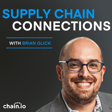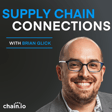
Episode 8 - Rob Garrison, CEO of Mercado Labs on Taking the ‘Complicated’ Out of Logistics.
PROFILES
SUPPLY CHAIN CONVERSATIONS
—————————————————
EPISODE 8 - ROB GARRISON, CEO OF MERCADO LABS. Taking the ‘Complicated’ Out of Logistics.—————————————————
Welcome to Episode 8 of Profiles, a podcast centered around supply chain conversations hosted by Brian Glick, founder and CEO of Chain.io.
Our guest this week is ROB GARRISON. With a background in logistics and import. He has a BA from Marketing from Baker University.
He was previously the Vice President of Supply Chain Design at UPS and has 20 years of experience in the field of transport and distribution. He built his current firm Mercado Labs to remove the challenges and frustrations that arise during the complex import process for people. Bringing import into the 21st century.
“….The broader definition of the supply chain: The four main activities are plan, buy, move, and sell. The supply chain is all 4 of those activities. Logistics is the ‘move’, and it’s incredibly important and it’s also incredibly complex. But it’s one of 4 steps that needs to occur in the supply chain”
Listen in as Brian and Rob discuss:
- Rob discusses his early days in the industry and what influenced him the most.
- The colourful characters of business and how personal relationships shaped Rob’s journey.
- What tools are available today to help with logistics and build international relationships?
- What Mercado offers as a business, and the reason Rob started it in the early days.
- What is the difference between the supply chain and logistics?
- Advice on expanding horizons within logistics and import. Keeping up with the world of e-commerce.
- What were some of the challenges Mercado faced in it’s early days?
- The importance of understanding customers needs through beta testing.
- Working hard to adapt to the market and it’s ever changing landscape.
- What is next for Mercado?
“….. If you are going to start a technology company one of your key considerations is to make sure you are either partnered with, or that you have, great technical skills, it’s such a huge part of it and I don’t underestimate that.”
Resources and Links:
Subscribe to the show in Apple Podcasts, Stitcher, or wherever you get your podcasts so that you’re updated when we post a new episode!
Take care, and until next time,
Brian Glick


